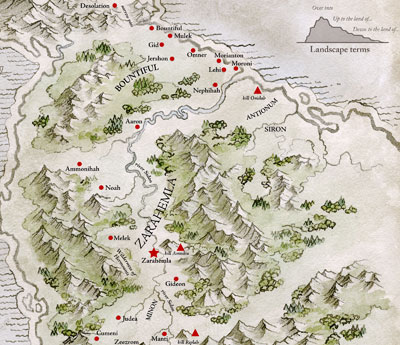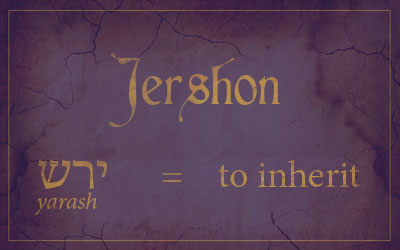
The Know
After their conversion, the people of Anti-Nephi-Lehi ran afoul of their former Lamanite kindred, whose “hatred became exceedingly sore against them” (Alma 24:2).1 After they suffered a massacre at the hands of the Lamanites (Alma 24:20–30), the Lord commanded Ammon to move the people of Anti-Nephi-Lehi closer to the Nephite polity in order to protect them from further aggression (Alma 27).
Eventually the “voice of the people came, saying: Behold, we will give up the land of Jershon, which is on the east by the sea, which joins the land Bountiful, which is on the south of the land Bountiful; and this land Jershon is the land which we will give unto our brethren for an inheritance” (Alma 27:22). Not only that, but Nephite armies were to be set “between the land Jershon and the land Nephi,” so as to protect the Anti-Nephi-Lehies from future attacks (v. 23). The text reiterated a second time that the Anti-Nephi-Lehies were relocated so “that they may inherit the land Jershon” (v. 24).
With the decision made, Ammon “returned to the people of Anti-Nephi-Lehi” (Alma 27:25) and with them “went down into the land of Jershon, and took possession of the land of Jershon; and they were called by the Nephites the people of Ammon; therefore they were distinguished by that name ever after” (v. 26).
As explained by Latter-day Saint scholars Stephen D. Ricks and Matthew L. Bowen, the name Jershon and the attending detail that it was a land of “inheritance” for the Anti-Nephi-Lehies is a fairly obvious Hebrew pun.2 The Hebrew verb yrsh (pronounced yarash) means “to take possession of” or “to inherit.”3 The nominal form (morashah/morash, “possession”) of this root is specifically used to describe the land of promise: “And I will bring you in unto the land, concerning the which I did swear to give it to Abraham, to Isaac, and to Jacob; and I will give it you for an heritage [morashah]: I am the LORD” (KJV Exodus 6:8).4
The Hebrew letter yod (y) is typically rendered in English with a J, as in the names Jehovah (YHWH or Yahweh) and Jerusalem (yerushalaim). Combining yrsh with the element –on (which in Hebrew toponymy may designate a place or location5) would easily render the name Jershon: “place of possession/inheritance.” Quite literally, then, Alma 27 depicts the Anti-Nephi-Lehies “inheriting” or “taking possession” of the “place of possession/inheritance.”
The Why
In keeping with biblical law, the newly-formed Anti-Nephi-Lehies would have required land in order to live the law of Moses or otherwise be subject to rules of inheritance and other property laws.6 On a more practical level, they required protection from Lamanite and Amlicite aggression, which would have most easily come after being securely stationed in their own land.7 The Anti-Nephi-Lehies were, essentially, refugees displaced by religious and political strife in need of protection and support. In following the earlier instructions of Benjamin and Alma, the Nephites imparted their substance to the Anti-Nephi-Lehies according to their need (Mosiah 4:17–19; 18:29).
With this gesture, the Nephites were also helping to fulfill the Lord’s promises in Alma 3 that repentant Lamanites could once more be numbered among Nephi’s seed. “Behold, the Lamanites have I cursed,” the Lord declared, “and I will set a mark on them that they and their seed may be separated from thee and thy seed, from this time henceforth and forever, except they repent of their wickedness and turn to me that I may have mercy upon them” (Alma 3:14).8 The Anti-Nephi-Lehies accepted the Lord’s invitation to repentance and “the curse of God did no more follow them” (Alma 23:18). As a result of their repentance, they were counted as Nephites (Alma 27:26).
Finally, the pun on the name Jershon (“place of inheritance”), with the detail that it was “inherited” by the Anti-Nephi-Lehies, reinforces the literary sophistication of the Book of Mormon. The Nephite chroniclers were adept at employing the subtleties of biblical Hebrew literary conventions, including the use of puns and plays on words, and did so in effectively communicating important narrative themes and doctrinal points.
Further Reading
Matthew L. Bowen, “‘They Were Moved with Compassion’ (Alma 27:4; 53:13): Toponymic Wordplay on Zarahemla and Jershon,” Interpreter: A Journal of Mormon Scripture 18 (2016): 233–253.
Stephen D. Ricks, “A Nickname and a Slam Dunk: Notes on the Book of Mormon Names Zeezrom and Jershon,” Interpreter: A Journal of Mormon Scripture 8 (2014): 191–194.
Stephen D. Ricks and John A. Tvedtnes, “Notes and Communications: The Hebrew Origin of Some Book of Mormon Place Names,” Journal of Book of Mormon Studies 6, no. 2 (1997): 255–59.
- 1. On the origin and name of the Anti-Nephi-Lehies, see Book of Mormon Central, “Why Did Converted Lamanites Call Themselves Anti-Nephi-Lehies? (Alma 23:17),” KnoWhy 131 (June 28, 2016).
- 2. Stephen D. Ricks, “A Nickname and a Slam Dunk: Notes on the Book of Mormon Names Zeezrom and Jershon,” Interpreter: A Journal of Mormon Scripture 8 (2014): 191–194; Matthew L. Bowen, “‘They Were Moved with Compassion’ (Alma 27:4; 53:13): Toponymic Wordplay on Zarahemla and Jershon,” Interpreter: A Journal of Mormon Scripture 18 (2016): 233–253.
- 3. Francis Brown, S. R. Driver, and Charles A. Briggs, A Hebrew and English Lexicon of the Old Testament, rep. ed. (Oxford: Claredon Press, 1953), 439; Ludwig Koehler and Walter Baumgartner, The Hebrew and Aramaic Lexicon of the Old Testament (Leiden: Brill, 2001), 441.
- 4. Compare Isaiah 14:22–23, where the Lord swears that Babylon will become “a possession [morash] of the hedgehog.” See also Deuteronomy 33:4; Ezekiel 11:15; 25:10; 33:24; 36:2, 5.
- 5. E.g. Ashkelon (Joshua 13:3; Judges 1:18; 14:19; 1 Samuel 6:17), Ekron (Joshua 13:3; 15:11, 45–46; Judges 1:18; 1 Samuel 5:10), Gibeon (Joshua 9:3, 17; 10:1–5; 2 Samuel 2:12; 1 Kings 9:2), Hebron (Genesis 13:18; 23:2, 19; Numbers 13:22; Joshua 10:3, 5), Lebanon (Deuteronomy 1:7; 3:25; Joshua 1:4; 1 Kings 4:33; 5:6), Heshbon (Numbers 21:25–28; 32:3; Deuteronomy 1:4; 2:26, 30), and Sharon (1 Chronicles 5:16; 27:29; Song of Solomon 2:1; Isaiah 33:9; 35:2). Much like Jershon, many of these names derive from a verbal root with the appended –on element denoting a place. Thus Hebron = “place of association” (from the verb chabar = “to associate”), Lebanon = “place of whiteness” (from the verb laban = “to be white”), Heshbon = “place of reckoning” (from the verb chashab = “to reckon, plot”), and Sharon = “plain, level place” (from the verb yashar = “to do good, make straight, smooth,” etc.).
- 6. Ze’ev W. Falk, Hebrew Law in Biblical Times (Provo, UT and Winona Lake, IN: Brigham Young University Press and Eisenbrauns, 2001), 83–87.
- 7. See also the commentary by John W. Welch explaining how the military exemption still requiring the Ammonites to provide supplies to Nephite troops was consistent with the Jewish interpretation of the exemptions under Deuteronomy 20: John W. Welch, “Exemption from Military Duty,” in Reexploring the Book of Mormon: A Decade of New Research, ed. John W. Welch (Salt Lake City and Provo, UT: Deseret Book and FARMS, 1992), 189–192.
- 8. For more on the Lamanite curse, see Book of Mormon Central, “What Does it Mean to Be a White and Delightsome People? (2 Nephi 30:6),” KnoWhy 57 (March 18, 2016); “Why Did Book of Mormon Prophets Discourage Nephite-Lamanite Intermarriage? (Alma 3:8),” KnoWhy 110 (May 30, 2016).
Continue reading at the original source →





